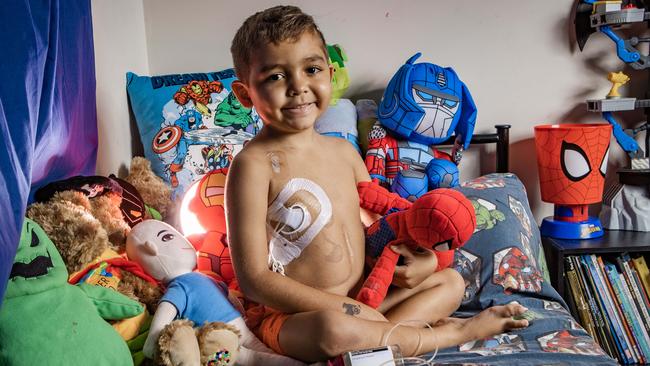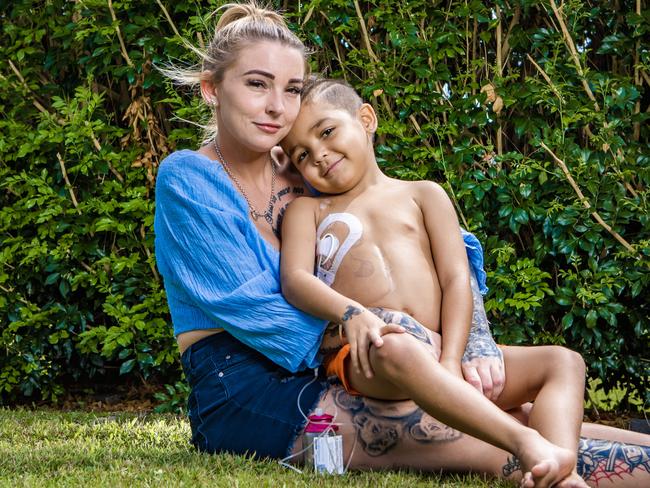Qld boy in limbo as lifesaving bone marrow transplant bungled
After being left on the tarmac at a US airport, a potentially life-saving bone marrow transplant for a little Queensland boy is now on its way to Australia, but its arrival may still not be enough.

Lifestyle
Don't miss out on the headlines from Lifestyle. Followed categories will be added to My News.
The potentially life-saving bone marrow transplant for a little Queensland boy is on its way to Australia after it was earlier left on the tarmac in the US instead of being loaded on a flight to Brisbane, but it still needs to be deemed viable for transplant, leaving his life in limbo.
Shalyn Eggleton said she feared her son Mateoh, 6, may not survive after she learned the horrific news from Queensland Children’s Hospital staff, who said her son Mateoh’s potentially life saving marrow was not sent after being left on the tarmac for an unknown amount of time.
Mateoh, 6, was diagnosed with chronic granulomatous disease in 2019 and in the last year alone trialled nine experimental treatments, all of which failed to cure his condition.
“This was our last hope for treatment, we do not have any options left,” Ms Eggleton said.
“He will die without this transplant.”
The treatment which is expected to arrive either on Friday or Saturday will be taken to the lab to be tested to determine whether Mateoh can still receive it.
“It is all dependent on whether these cells are still viable, and if they aren’t then it is not good at all,” Ms Eggleton said.
“It is amazing the outcome and honestly can’t thank everyone enough for getting behind ‘Teoh but we also want to know who is responsible for this so it doesn’t happen to anyone else.”
Australian Bone Marrow Donor Registry CEO Lisa Smith said the registry was aware of an incident involving an extended delay to the delivery of blood stem cells from the US, and that an urgent investigation is underway to determine the cause
“All efforts are made to reduce the risk of transport-related incidents, and unfortunate incidents such as this are relatively rare,” she said.
Mateoh received a transplant last year to treat his chronic granulomatous disease which was successful.
But as a result of the treatment he was diagnosed with a new life-threatening condition – haemolytic uraemic syndrome – causing his red blood cells to attack his body.
Mateoh’s mother launched a desperate bid to find a match for her son and thought her prayers were answered when she found one in Britain who was on the stem cell donor list.
Unfortunately, for reasons unknown to the family and staff at the children’s hospital, the donor declined the transplant, leaving the critically ill six-year-old back on adult chemotherapy drugs and blood transfusions to prolong his life.
So when a match was found in the US, the young family was thrilled.
“We haven’t been given a reason at all as to how it could have been left behind; it could be a company or could be an individual, I just don’t know. It is meant to be supervised at all times, it’s a lifesaving treatment for a very sick little boy, not a birthday present,” Ms Eggleton said.
“Mateoh was there when the doctor informed me and all he said was, ‘does that mean no transplant’ which he knows is his last option to stay alive.”
The Australian Bone Marrow Donor Registry is responsible for arranging and transporting bone marrow and blood stem cell donations for patients in Australia, working closely with hospitals to ensure transplants go smoothly.

A spokeswoman for Queensland Children’s Hospital said Mateoh has been a long-term patient at the Queensland Children’s Hospital and his care team shared the family’s disappointment at the delay in the delivery of his donor cells.
“Mateoh’s donor cells are currently in transit to Australia and their delayed arrival will not adversely impact Mateoh’s care,” she said.
“At all times our priority has been ensuring the donation remains viable so Mateoh’s bone marrow transplant can safely proceed.”
Australia’s donor pool no longer meets the needs of Australians and patients are increasingly dependent on overseas donors.
About eight out of 10 Australian patients rely on an overseas donor for a bone marrow transplant.
Mateoh had recently undergone four weeks of treatment to prepare for the transplant and was about to begin nine days of conditioning which his doctors said could have left the six-year-old in ICU on a ventilator.
“He knows he is very sick, he knows this is the last transplant, he doesn’t understand the full details but he knows we have trialled everything,” Ms Eggleton said.
“I’m holding in there because I have to, I don’t have family up here and Mateoh’s father isn’t in the picture so it’s just me and him. I’m staying strong because I watch him being strong.”
Ms Eggleton is pleading with the Australian public to join the stem cell donor list which takes two extra minutes when donating blood.
The ABMDR is seeking approval from governments to increase the recruitment of local donors, to reduce Australia’s dependence on overseas donors and transportation.
Until the funding is introduced younger Queenslanders under 35 are encouraged to inquire about joining the stem cell donor registry when they donate blood.
If potential stem cell donors are not eligible to donate blood and wish to join the registry they can contact Lifeblood on 13 14 95 to discuss their options.




